ParkinsonSat (PSat or Naval Academy OSCAR 84)
Non-EO
Mission complete
USNA (United States Naval Agency)
Technology and Research
Quick facts
Overview
| Mission type | Non-EO |
| Agency | USNA (United States Naval Agency) |
| Mission status | Mission complete |
| Launch date | 20 May 2015 |
| End of life date | 26 Jun 2018 |
ParkinsonSat (PSat or Naval Academy OSCAR 84) - Remote Data Relay
Spacecraft Launch Communication Experiments Mission Status References
ParkinsonSat is a student 1.5 U CubeSat project of the US Naval Academy (USNA), Annapolis, MD, USA . The initiative is sponsored in part by The Aerospace Corporation and by ONR (Office of Naval Research). The project is named in honor of Bradford W. Parkinson (an American engineer and inventor, and United States Air Force colonel) who is best known as the father of the US GPS system.
PSat (short for ParkinsonSat) employs a two- way communications transponder for relaying remote telemetry, sensor and user data from remote environmental experiments (in the ground segment) or other data sources back to experimenters via a global network of Internet linked volunteer ground stations. The data transponder also includes all telemetry, command and control for a complete CubeSat. 1) 2) 3)
The spacecraft carries two transponders, one serving the ODTML (Ocean Data Telemetry Microsat Link) mission for DoD (Department of Defense) and the other operating in the Amateur Satellite Service to encourage students, educators and experimenters around the world to contribute buoys or additional satellites.
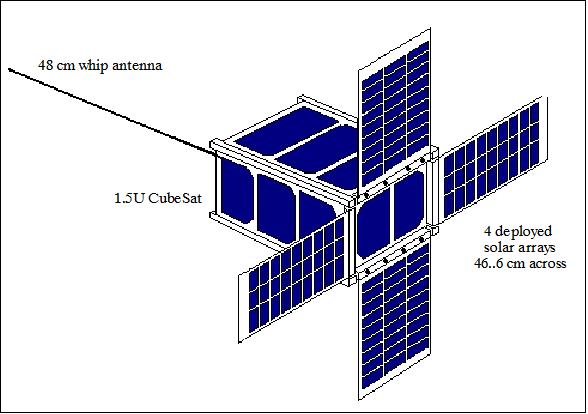
Spacecraft
The spacecraft corresponds to a standard 1.5U CubeSat in size so that two PSats can be launched from the same P-POD launcher. The design uses four deployable solar arrays which are stowed down the sides in the pre-deployment state. The available payload volume is 640 cm3 as shown in Figure 2. The 5 W RF transponder has a volume of 295 cm3 which means that about half of the payload volume is available for auxiliary payloads or experiments.
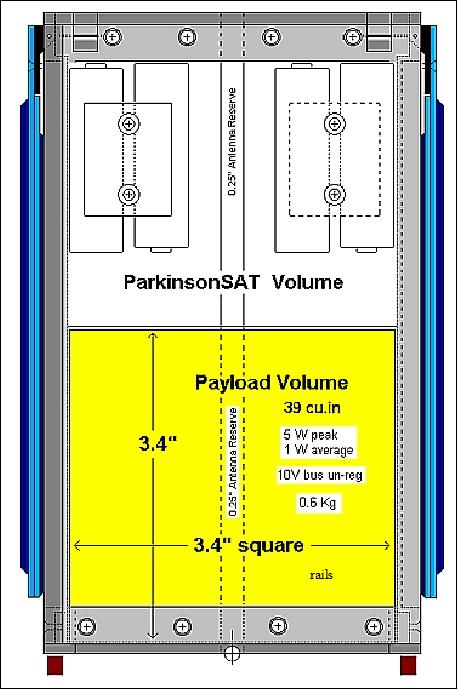
ADCS (Attitude Determination and Control Subsystem)
The ADCS consists of a sun sensor, a magnetometer and a set of three orthogonal torque coils. It senses its attitude with respect to the sun and senses its orientation with respect to the local magnetic field, then it computes the needed torque to apply to the proper coils to not only bring it into alignment with the sun, but also to maintain a slow spin about the sun axis so that it will coast through eclipse and be reasonably pointed at the sun when it comes back out of eclipse.
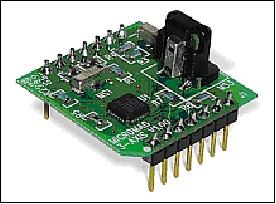
Launch
The ParkinsonSat (PSat) nanosatellite was launched on May 20, 2015 (15:05:00 UTC) as a secondary payload on an Atlas-5 -501 EELV (Evolved Expendable Launch Vehicle) of ULA from the Cape Canaveral Air Force Station (SLC-41) in Florida. The primary mission was the AFSPC-5 (Air Force Space Command -5) mission -referring to the Boeing built X-37B spaceplane of the USAF into LEO. The X-37B is an unmanned reusable mini shuttle, also known as the Orbital Test Vehicle (OTV) and is flying on the OTV-4 mission. It launches vertically like a satellite but lands horizontally like an airplane. The X-37B mission is testing an electric Hall Effect thruster in its small payload bay, which will be used on future US Air Force satellites. 4) 5)
This Atlas-5 mission also includes the ABC (Aft Bulkhead Carrier) carrying the NRO's (National Reconnaissance Office's) Ultra Lightweight Technology and Research Auxiliary Satellite (ULTRASat).
Secondary Payloads
The Atlas V sent the U.S. Air Force's X-37B space plane on its fourth mission, which also is carrying NASA's METIS (Materials Exposure and Technology Innovation in Space) investigation that will expose about 100 different materials samples to the space environment for more than 200 days. 6) 7) 8)
ELaNa-XI CubeSats: NASA will enable the launch of a small research satellite, or CubeSat, for The Planetary Society in Pasadena, California, as part of the eleventh installment of the Educational Launch of Nanosatellite (ELaNa) mission. The LightSail CubeSat is included as part of an auxiliary payload of 10 CubeSats on the upper stage of the Atlas V rocket that was launched on the U.S. Air Force X-37B space plane's fourth mission. 9)
The upper stage of the Atlas-5 included the National Reconnaissance Office's third auxiliary mission to launch CubeSats. The ULTRASat (Ultra Lightweight Technology and Research Auxiliary Satellite) carried 10 CubeSats from five organizations. It was made possible through agreements between NASA, the Air Force's Space and Missile Systems Center and the NRO (National Reconnaissance Office) to work together on CubeSat integration and launch opportunities. 10)
• LightSail-A, a 3U CubeSat of The Planetary Society, Pasadena, CA.
• USS (Unix Space Server) Langley, a 3U CubeSat of the USNA (U.S. Naval Academy) Annapolis, MD. USS Langley is a proof-of-concept mission for providing global Internet access via a nanosatellite constellation. The USS Langley satellite uses a 3U CubeSat bus procured from Pumpkin Inc. under the Colony-1 program of the National Reconnaissance Office.
• BRICSat-P (Ballistic Reinforced Communication Satellite-Propulsion Test Unit), a CubeSat of USNA /George Washington. BRICSat-P is a collaborative 1.5U CubeSat mission of USNA, Annapolis, MD, and the George Washington University, Washington DC, USA. The primary objective is to demonstrate on-orbit operation of an electric propulsion system. 11) 12)
• ParkinsonSat, two 1.5U CubeSats of the USNA (United States Naval Academy). PSat (short for ParkinsonSat) employs a two- way communications transponder for relaying remote telemetry, sensor and user data from remote environmental experiments (in the ground segment) or other data sources back to experimenters via a global network of Internet linked volunteer ground stations. The data transponder also includes all telemetry, command and control for a complete CubeSat.
• GEARRS-2 (Globalstar Experiment And Risk Reduction Satellite-2), a 3U CubeSat of NSL (Near Space Launch Inc.). The objective is to demonstrate whether the Globalstar satellite constellation can be used to relay commands and telemetry for a small satellite mission.
• AeroCube-8A and AeroCube-8B, two 1.5U CubeSats of The Aerospace Corporation, El Segundo, CA. The objective is to test the use of carbon nanotubes in spacecraft construction and radiation protection and investigate electric propulsion technologies. Also known as IMPACT, the two satellites are identical and will be deployed together from a single P-POD.
• OptiCube-1, OptiCube-2, OptiCube-3, three 3U CubeSats of Cal Poly of SLO (San Luis Obispo, CA. The goal of the three OptiCubes is to serve as tracking and calibration targets for studying small satellites and debris in orbit.
All CubeSats are integrated into 8 P-PODs (Poly-Picosatellite Orbital Deployers) which are contained in the NPSCuL (Naval Postgraduate School CubeSat Launcher), built by the NPS (Naval Postgraduate School). The NPSCuL together with the 8 P-PODs and 10 CubeSats is referred to as the ULTRASat (Unique Lightweight Technology and Research Auxiliary Satellite), and is attached to the Centaur upper stage's ABC (Aft Bulkhead Carrier). The assembled ULTRASat is shown in Figure 4 the photo below ready for mate to the launch vehicle along with members of the ULTRASat team consisting of NPS, Office of Space Launch (OSL), United Launch Alliance (ULA) and Cal Poly. 13)
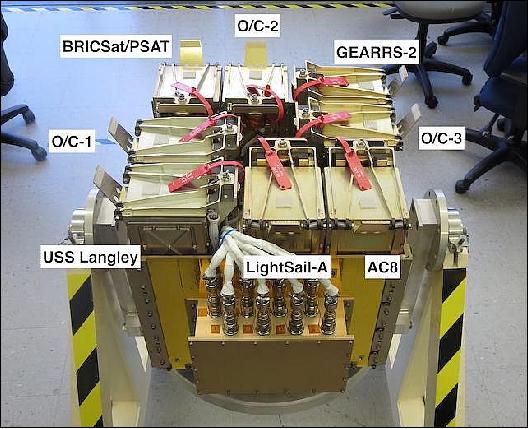
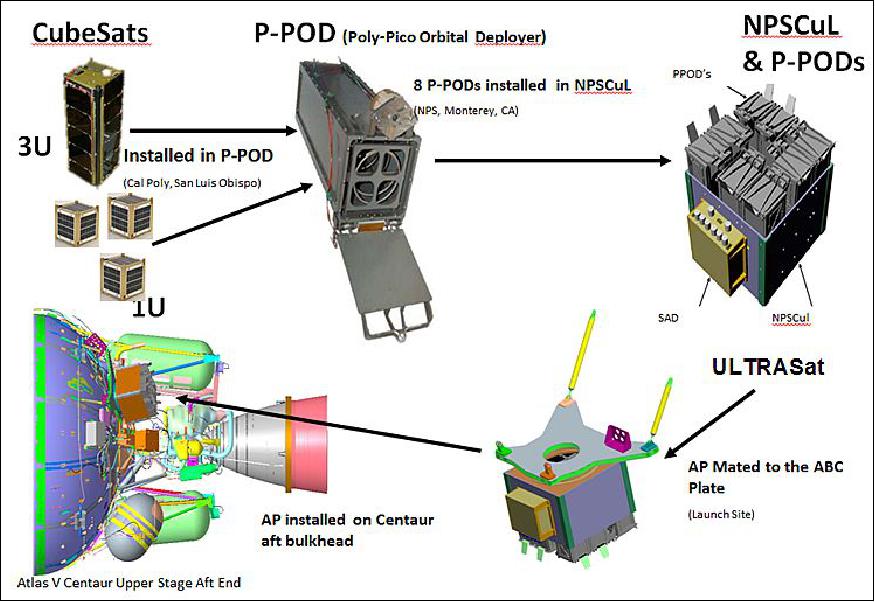
Orbit
The two ParkinsonSat-P CubeSats, as well as all secondary payloads, were released into an elliptical orbit, altitude of 350 km x 700 km, eccentricity=0.0253 and an inclination of 55º.
Communication Experiments
PSat is another APRS satellite that can digipeat user packets just like the original PCSAT (NO44) and the packet system on the ISS. PSAT also supports the same digipeating alias of ARISS so that users do not have to change any parameters when using any of these three APRS transponders. If users want to target only a single satellite, they can use the actual spacecraft callsign. PSAT for PSAT, RS0ISS for the ISS, and W3ADO-1 for PCSAT. 15)
But the real excitement is the PSK-31 transponder that is also on PSAT: It permits dozens of simultaneous PSK31 users to operate full duplex and maintain a continuous group dialog throughout the pass. But operating full duplex on PSK-31 is new and it will take a while for users to figure out how to do this. KO6TD has prepared Table 1 of capabilities of typical PSK-31 user software. Only WinPSK can operate full dupled, but others can run two instances of the same software, one for transmit and one for receive.
Program | Duplex | 2 copies | Channels | AFC (Hz) | PSKmax | Tx-mon | Multi |
WinPSK | F-DX | NA | 1 | 3 k | 63 | N | N |
WinPSK (SE) | F-DX | NA | 2 | 3 k | 31 | N | N |
F1Digi | SimpxX | Y | SB | 50 | 1 k | Y | 1 |
DigiPAN | Simpx | Y | SB | 50 | 63 | N | 3 |
MixW | Simpx | Y | 2 | 50 | 125 | N | ? |
DM780 | Simpx | N | SB | ?50 | 125 | N | 8 |
PSK-31 Transponder
The PSK31 transponder is intended for the use in the CubeSat type satellite PSat as single board with connection to other parts of the satellite. The single channel 3 kHz bandwidth is intended for multiple PSK31 transmissions through the transponder with the FM signal downlink. Additionally the beacon is implemented to identify the channel and to give info about the transponder's health. 16)
A block diagram of the HF receiver part of the band monitor is depicted in Figure 6. A double conversion super heterodyne technique is used, proven in the PCSAT-2 receiver, with several modifications - especially regarding the BPSK31 signal sensing circuits.
The receiver includes low noise preamplifier with BFS17 in order to compensate electrically the short receive antenna, which must be shorter to fit in the small CubeSat. The LNA (Low Noise Amplifier) is followed by high quality LC filter for the out of band signal suppression. Then there is the first mixer, NE602 ,to intermediate frequency followed by a crystal filter, which defines the actual bandwidth 3 kHz of the monitored HF band. The intermediate frequency amplifier, A281D, with the gain setting ability for automatic gain control then amplifies the received signal and it is followed by the last mixer, NE602, which converts the signals to the audio band.
The baseband signal is then split into three ways. The first signal is rectified and the obtained DC voltage controls the gain of the intermediate amplifier via the MC34072 amplifier.
The second signal is rectified to obtain a 31.25 Hz frequency from the received signals. Then it is amplified and filtered by MC34072. This spectral component is a part of the BPSK31 signal modulation which is the most frequently used digital mode in the monitored radio-amateur band. After passing through the narrow bandwidth tone decoder, NE567, the binary signal carrying the information about the presence of BPSK31 modulation, is obtained. It is monitored by a control microprocessor of the transmitter in order to recognize useful signals and switch the power amplifier on.
The third signal is also amplified by the MC34072 device, which also works as amplitude limiter and through a preemphasis filter, it is connected to the transmitter modulation input to modulate the UHF carrier.
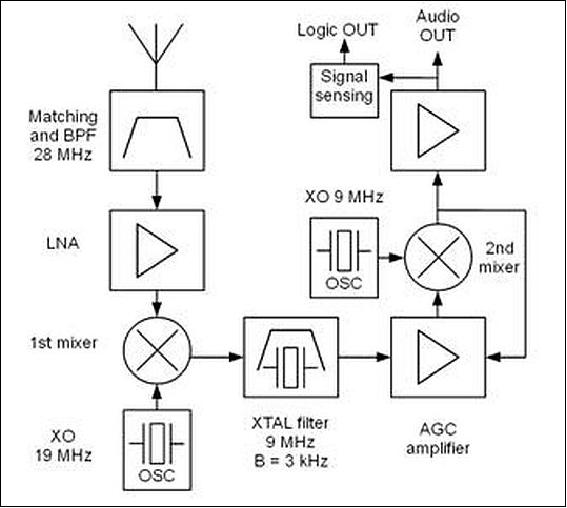
The transmitter produces the FM modulated signal in the UHF frequency band. The output RF power of the transmitter is 27 dBm at 435 MHz. A BPSK modulator with data rate 31.25 bit/s on a subcarrier with frequency 312.5 Hz is implemented in order to transmit the telemetry data from the built-in sensors. A block diagram of the transmitter is depicted in Figure 7.
The core of the transmitter is the integrated transceiver IC ADF7021, produced by Analog Devices. This solution, with a minimum number of external components, results in minimal dimensions of the PCB board. The ATMega8 3.686 MHz quartz oscillator is directly modulated by a varicap, in order to achieve a linear FM modulation. The output power is amplified by a one-stage PA, with a Mitsubishi RD02MUS1B MOSFET transistor. On the board are implemented sensors which measure drain voltage, current (MAX4372) and temperature (AD7415) of the PA transistor and also the output RF power (LTC5531) - not used. All sensors and the transceiver IC, are controlled by the microcontroller ATmega8. The microcontroller also drives a 5-bit parallel DA converter, which provides BPSK modulation of the telemetry data. The board uses a 1.5 mm FR4 material with a size of 91.4 mm x 91.4 mm.
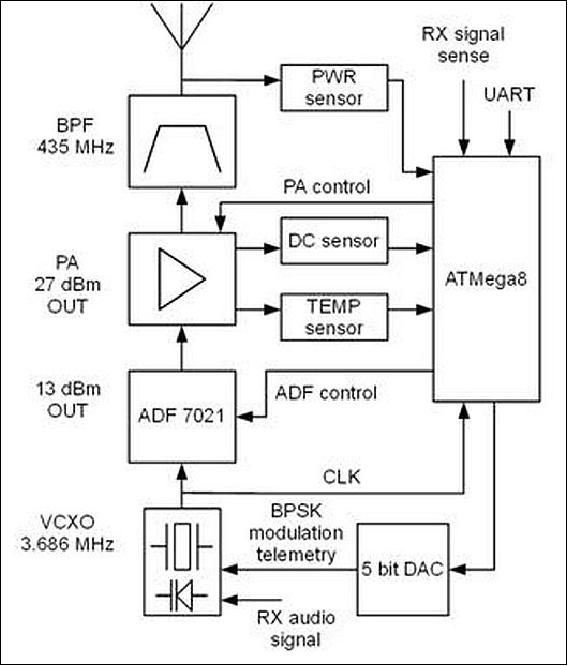
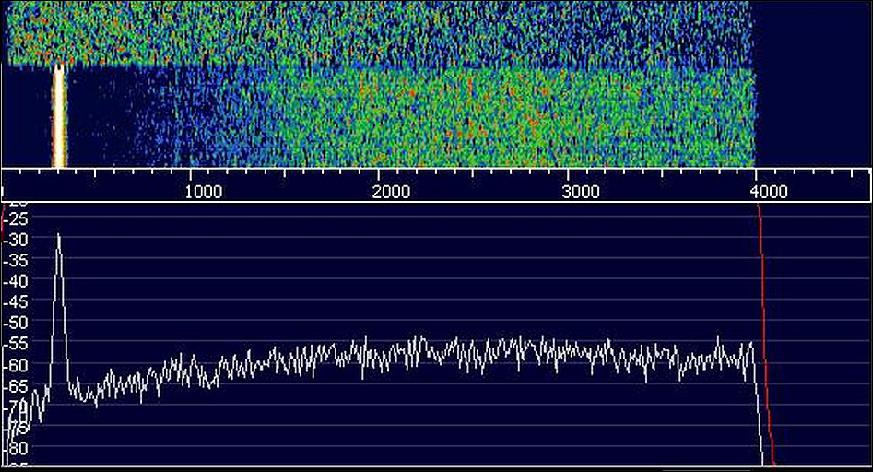
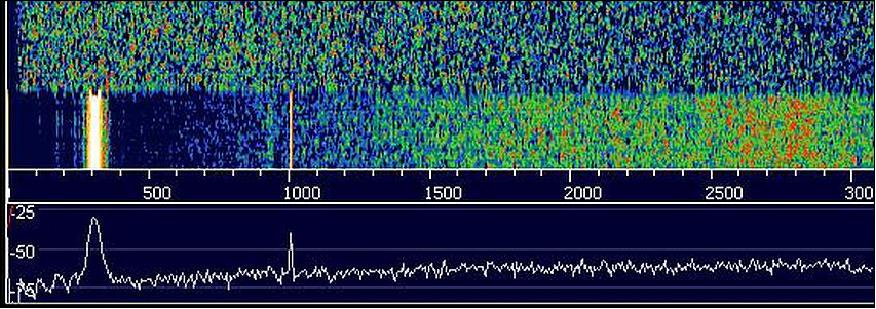
Figure 9 shows the result of CW signal injection into the transponder with frequency 28.TBA MHz. The signal is at the 1000 Hz mark. From that we conclude the input frequency:
• F LO = 28.119660 MHz
• And resulting operating passband range: 28.120160 MHz - 28.122560 MHz
• Output center frequency: 435.350 MHz with FM modulation
The PSK31 text messaging transponder allows messaging between up to 30 modest ground stations simultaneously.
Realized Transponder
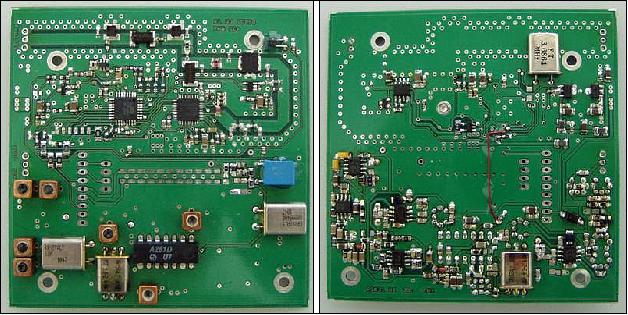
APRS (Automatic Packet Reporting System)
APRS is digital communications protocol for exchanging information between a large number of stations covering a large (local) area. As a multi-user data network, it is quite different from conventional packet radio. 17)
APRS is different from regular packet in four ways.
• First: by the integration of maps and other data displays to organize and display data,
• Second: by using a one-to-many protocol to update everyone in real time,
• Third: by using generic digipeating so that prior knowledge of the network is not required,
• Forth, since 1997, it is a worldwide transparent Internet backbone, linking everyone worldwide.
APRS turns packet radio into a realtime tactical communications and display system for emergencies and public service applications (and global communications). Normal packet radio is useful in passing bulk message traffic (email) from point-to-point, but it does not do well at real-time events where information has a very short life time and needs to get to everyone quickly.
APRS is a local RF network. Although the Internet monitors APRS worldwide, this is not the primary objective. But like all of our other radios, how we use APRS in an emergency of special event is what drives the design of the APRS protocol. Although APRS is used 99% of the time over great distances, and benign conditions, the protocol is designed to be optimized for short distance real-time crisis operations on RF.
Mission Status
• August 2017: PSAT is an example of the Naval Academy students' satellite development projects, designed specifically in the Amateur Satellite Service for the student's education and self-training at the undergraduate level in radio/ satellite technology. Since its launch on 20 May of 2015, the satellite has been successfully operating and remains fully functional. As an Amateur Radio Service satellite, it has been providing data relay service to the Amateur radio operators around the world, with more than 22,121 user downlink packets digipeated as of January 2017. 18)
- This user data, together with more than 57,972 telemetry packets also gathered by ground stations around the world, provide valuable insights to the PSAT system operation, on-orbit behavior, and also global satellite communication usage in the Amateur Radio Service world. In addition to the communication payloads, PSAT also has many unique student design features, including a passive spacecraft spin using the radiometric spin torque for passive thermal control and effective power generation. As can be seen from the data analyses presented, spacecraft spinning was accomplished successfully on-orbit, and telemetry show healthy satellite system status. PSAT will continue to make a positive impact on the Amateur Satellite Service community as it continues to provide global data relay service for another 3 or 4 years before de-orbit.
• January 14, 2017: PSAT entered a 4 day full sun period on 10 January and the project happened to collect some spin data. DK3WN captured spin data on 8 January while eclipses were at 26 minutes showing about 9.4 RPM, but by 14 January it was noted by KO6TZ to have spun up to 11.7 RPM. The PSAT spin is a result of the radiometric torque from the differential color on each of its XY sides of the solar panels (Figure 11). The project didn't need this much spin, just enough to keep the sides thermally moderate. 19)
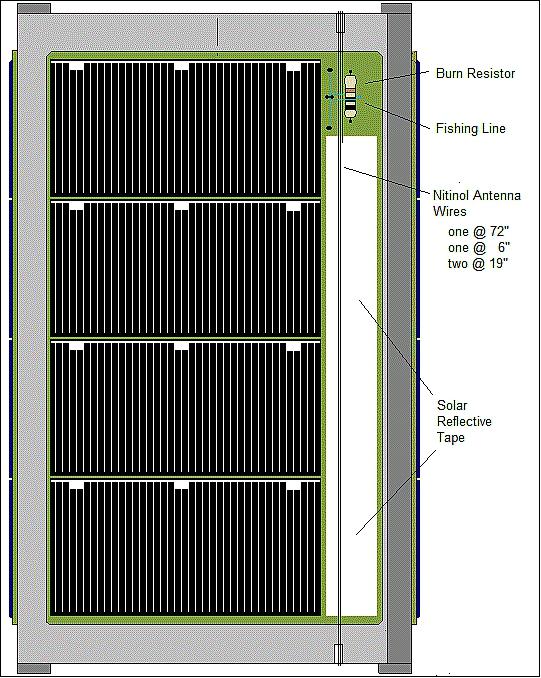
• According to Mike Rupprecht, PSAT is operational as of April 2016. 20)
• May 28, 2015: The APRS/PSK31-equipped US Naval Academy satellites, two 1.5 U CubeSats called PSAT, appear to be operating, with one exception, according to Bob Bruninga, WB4APR. 21)
• May 24, 2015: The PSAT PSK31 435.350 MHz FM downlink is full quieting with 6 bars using a decent UHF Yagi. But we have not seen any users other than those using the 28.120 PSK channel on HF normally. We welcome people to experiment with it. Everyone within the 28.120 to 28.123 MHz ten meter passband will be uplinked and heard on the 435.350 MHz downlink. The Naval Academy's PSAT seems healthy with plenty of power (we are keeping the APRS digipeater off to allow max power for PSK31). 22)
• PSAT is spinning about the Z axis as designed. On the 3rd day after launch, the radiometric spin about the Z axis was about 3.0 rpm with the +Z axis pointed about 45º off the Sun. This gives max power as all three axes are always illuminated. One can see how the project manually decoded the S#... status packet alphabet soup to plot the 1 minute spin samples in the photo of Figure 12. Alternately, one can see how Ken Ernandes later plotted the data. By the end of the sun side of the orbit, the +Z panel reached +60ºC. By day 10 after launch, the spin rate was down to 0.62 rpm (Ref. 15).
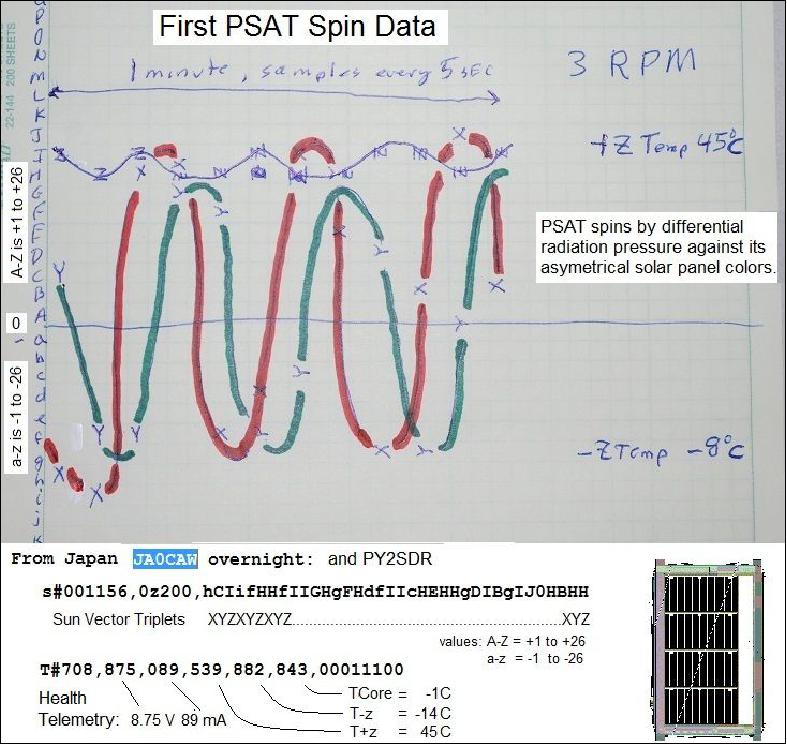
• After the launch on May 20, 2015, deployment of PSat occurred an orbit later over Texas; the delayed 50 minute timer activation occurred over New Zealand. The first packets were acquired on the next orbit over the USA. All systems go except a code error - it means we have lost 1-of-3 backup on-orbit reset capabilities, and another bug does not allow smart power management via reduction of routine packets in the dark. But so far, these are not critical. We are operating now at full power (Ref. 15).
References
1) Bob Bruninga, et al., "Psat Design Page - ParkinsonSAT," URL:
http://www.aprs.org/psat.html
2) Bob Bruninga, Midshipmen: Buck, Kimball, Lung, Mahelik, Rehume, Percelli, Rose, Yuhaniak, "ParkinsonSAT Remote Data Relay (Psat)," 2012 Summer CubeSat Developers' Workshop, Logan, Utah, USA, Aug. 11-12, 2012, URL: http://www.cubesat.org/images/stories
/Summer_Workshop_2012/Day_2/945_Bob_Bruninga.pdf
3) Bob Bruninga, "PSat and the APRS Space Network," 2010 AMSAT Conference, URL:
http://www.aprs.org/psat/AMSAT-2010c.doc
4) "United Launch Alliance Successfully Launches X-37B Orbital Test Vehicle for the U.S. Air Force," ULA, May 20, 2015, URL:
http://www.ulalaunch.com
/ula-successfully-launches-afspc5.aspx
5) Ken Kremer, "X-37B Air Force Space Plane Launches on 4th Mystery Military Mission and Solar Sailing Test" Universe Today, May 20, 2015, URL: http://www.universetoday.com/120396
/x-37b-air-force-space-plane-launches-on-4th
-mystery-military-mission-and-solar-sailing-test/
6) Stephanie Schierholz, Jason Davis, Loretta DeSio, "NASA's CubeSat Initiative Aids in Testing of Technology for Solar Sails in Space," NASA, May 20, 2015, Release 15-101, URL: http://www.nasa.gov/press-release/nasa-s-cubesat-initiative
-aids-in-testing-of-technology-for-solar-sails-in-space
7) Stephanie Schierholz, Tracy McMahan, "NASA Test Materials to Fly on Air Force Space Plane," NASA, May 6, 2015, Release 15-081, URL: http://www.nasa.gov/press-release
/nasa-test-materials-to-fly-on-air-force-space-plane
8) Patrick Blau, "AFSPC-05 Secondary Payloads," Spaceflight 101, URL: http://www.spaceflight101.com
/afspc-05-secondary-payloads.html
9) "ELaNa XI CubeSat Launch on AFSPC-5," NASA, May 2015, URL: http://www.nasa.gov/sites/default
/files/files/ELaNa-XI-Factsheet-508.pdf
10) "Atlas V AFSPC-5: ULTRASat CubeSat Summary," URL: http://www.ulalaunch.com/uploads/docs/Launch
/AtlasV_AFSPC-5_ULTRASat_CubeSat_descriptions.pdf
11) Christopher Dinelli, Samudra Haque, Jin Hang, Michael Keidar, Kristen Castonguay,"Ballistic Reinforced Communication Satellite (BRICSat-P): The First Flight of an Electric Micropropulsion System for CubeSat Mission Applications," Proceedings of iCubeSat 2014, 3rd Interplanetary CubeSat Workshop, Pasadena, CA, USA, May 27-28, 2014, URL: https://icubesat.files.wordpress.com/2014/05
/icubesat-org_2014_b-2-4-bricsat-p_dinellie_201405281748.pdf
12) Joseph Lukas, George Teel, Samudra Hague, Alexey Shashurin, Michael Keidar, "Thruster Subsystem Design for the Ballistic Reinforced Communication Satellite (BRICSat-P)," Proceedings of the AIAA/USU Conference on Small Satellites, Logan, Utah, USA, August 2-7, 2014, Pre-Conference: CubeSat Developers' Workshop, paper: SSC14-WK-18, URL: http://digitalcommons.usu.edu/cgi
/viewcontent.cgi?filename=0&article
=3155&context=smallsat&type=additional
13) "CubeSat in the News -Atlas V ULTRASat Launch 2015," URL:
http://www.cubesat.org/
14) "Atlas V AFSPC-5: ULTRASat CubeSat Summary," URL: http://www.ulalaunch.com/uploads/docs/launch
/atlasv_afspc-5_ultrasat_cubesat_descriptions.pdf
15) Bob Bruninga, "PSAT - APRS plus a new PSK31 Approach ," USNA, URL:
http://www.aprs.org/psat.html
16) T. Urbanec, P. Vágner, M. Kasal, "PSat Transponder WEB Specification," Brno University of Technology, Czech Republic, April 2015, URL: http://www.urel.feec.vutbr.cz/esl/files/Projects
/PSAT/P%20sat%20transponder%20WEB%20spec02.htm
17) Bob Bruninga, "Automatic Packet/Position Reporting System (APRS)," Sept. 18, 2002, URL:
http://www.aprs.org/APRS-docs/APRS.TXT
18) Bob Bruninga, Jin S. Kang, Jeffery T. King, James Thurman, "PSAT: University Amateur Radio Satellite Success Story –Mission Review and Lessons Learned from 18 months on Orbit," Proceedings of the 31st Annual AIAA/USU Conference on Small Satellites, Logan UT, USA, Aug. 5-10, 2017, paper: SSC17-WK-42 (Pre-Workshop Session 4: Lessons Learned), URL: http://digitalcommons.usu.edu/cgi
/viewcontent.cgi?article=3549&context=smallsat
19) Bob Bruninga, "PSAT - APRS and a new PSK31 Approach," Jan. 14, 2017, URL:
http://aprs.org/psat.html
20) Mike Rupprecht, "ParkinsonSat (NAVAL OSCAR-84)," March 20, 2016, URL:
http://www.dk3wn.info/sat/afu/sat_psat.shtml
21) "USNA APRS/PSK31 CubeSats Offer Something Different," ARRL, May 28, 2015, URL:
http://www.arrl.org/news/usna-aprs
-psk31-cubesats-offer-something-different
22) Bob Bruninga, "PSAT PSK31 CubeSat update," Southgate Amateur Radio News, May 25, 2015, URL: http://www.southgatearc.org/news/2015
/may/psat_psk31_cubesat_update.htm#.VXMG5UY_Puo
The information compiled and edited in this article was provided by Herbert J. Kramer from his documentation of: "Observation of the Earth and Its Environment: Survey of Missions and Sensors" (Springer Verlag) as well as many other sources after the publication of the 4th edition in 2002. - Comments and corrections to this article are always welcome for further updates (eoportal@symbios.space).
Spacecraft Launch Communication Experiments Mission Status References Back to Top